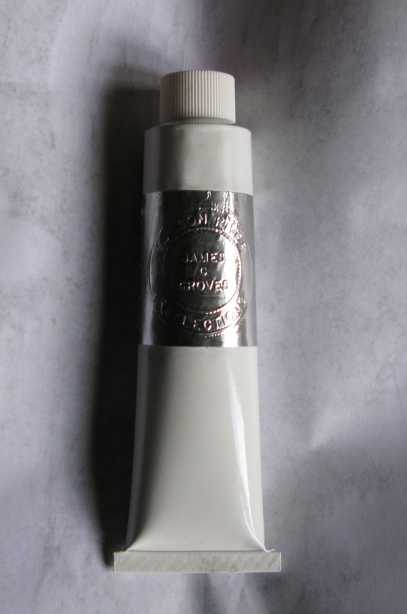
For Ordering Online click here
Email the Gallery at
wmg@jamescgroves.com
Copal Jelly

Copal Jelly Painting Medium Large 120 mil. (4 Ounces) Tube is $25.50
Our popular "Gelling Varnishes" have been supplied to practicing oil painters since 1999. These excellent and unique varnishes were heretofore only produced in a liquid form, which necessitated being mixed or "rubbed up" with an oil just before use. The created jelly could be stored for short periods before it slumped or separated; however, there was no real shelf-life. After many years of experimentation I succeeded in creating the jelly in such manner that it could be pre-made then stored as a jelly within a tube; thus, "Copal Jelly" was created. Copal jelly has the same ingredients and nothing more than the original "Gelling Copal Varnish". It contains only the following ingredients: Copal resin, a common but heat-processed painting oil, a small amount of turpentine (so very little that my own nose cannot detect its presense), and lead. The secret to having it all "gel" lies with the method and manner of the cooking-process. There is no mastic, fumed silica, wax, or anything else in the formula than the four materials cited.
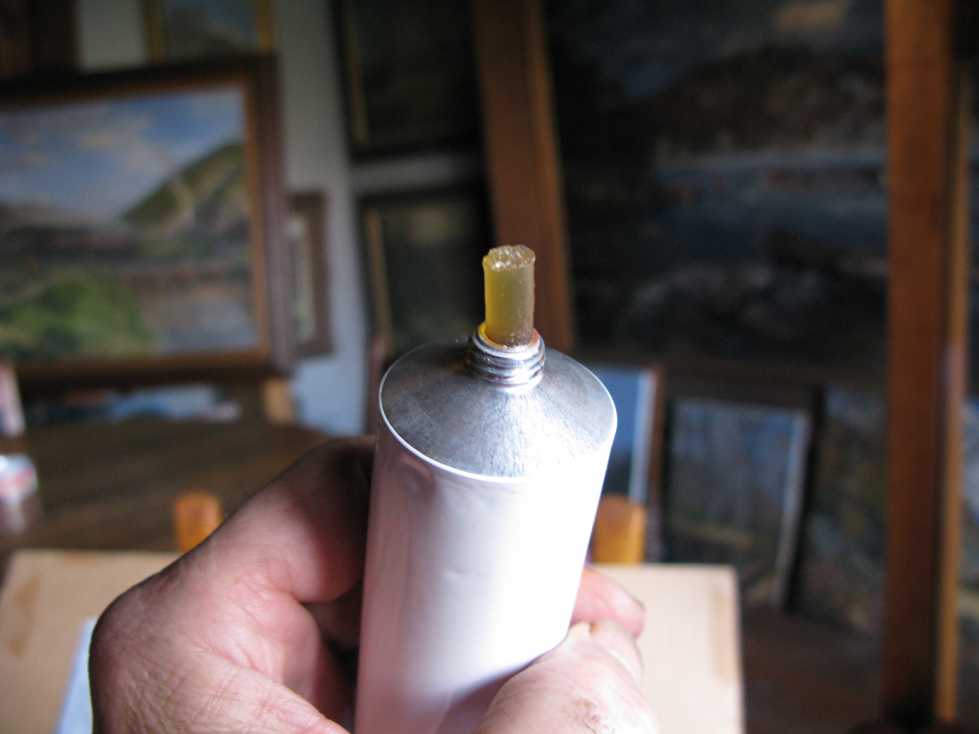
Copal Jelly thickens and transparentizes home-made or commercial 'tube' paints. The treated paint will dry in about 12-24 hours and retain every stroke created. The jelly may be added to paints in any desired proportion, though it is formulated especially to be used in equal amounts or less to the paint. Equal amounts only applies to the colors; "whites" can handle much less-- a half-amount being excellent. Copal Jelly is meant to extend and transparentize the colors --so necessary to a layering approach. That mentioned, Copal Jelly also allows the creation of excellent impasto; and is ideal for use in an alla prima manner.
Copal Jelly is perfect for use with true asphaltum paint. Like Origin and Fir Wax, Copal Jelly allows the fine transparent brown to keep its place and dry perfectly. As far as I know, true asphaltum is not currently offered by any artist's paint company, which is a shame because there is no finer means for sketching or laying-in the monochrome or chiaroscouro. DeMayerne gave instruction for the creation of the typical 1600's asphaltum -- a brown conjured from a solid glass-y rock; which has suffered great condemnation in the many years since. According to my own tests (and MOLART's tests), asphaltum is a permanent and non-hazardous transparent brown when formulated and applied correctly. The true culprits are the similar and supposedly "safe" browns known variously as Cassel earth, Cologne earth, Vandyke brown and Rubens brown. These similar browns all contain humis, which is the forever-plastic matter that causes eventual movement within the paint-layer. Ditto the tempting brown known as bitumin; and also 'mummy brown', a color based upon bitumin, which was utilized to impregnate and seal the mummy wrappings. (Realize, bitumin is tar, a substance that never dries.).
I have been making true oil or spirit asphaltum paint for some fellow painters for several years, now. I currently offer 40 mil. tubes of the true and well-behaved 1600's asphaltum oil paint on this site. I have tested asphaltum oil paint with both Roberson's Medium and the Copal Jelly. Both do work well, though the Copal Jelly offers the best retention of the stroke and the least 'drying slump'--especially when using the solvent-technique.
The following image shows true asphaltum mixed with Copal jelly (left) and Roberson's Medium (right):

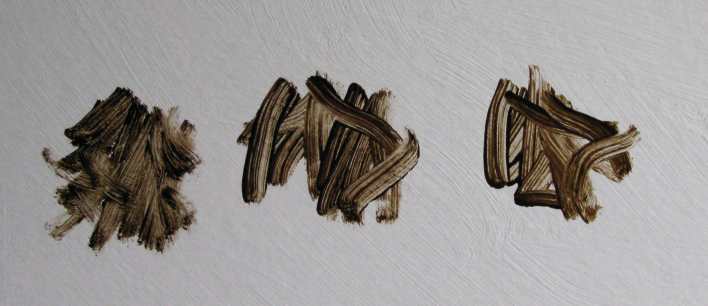
The image above shows asphaltum straight from the tube (left); asphaltum combined with Copal Jelly (middle); and asphaltum combined with Roberson's Medium (right). All samples have dried. Note the vivacity of the brushstroke incurred via the use of the jelly-additions.
James C. Groves
Frostburg, Maryland
October, 2016
What follows hereafter is the original 2005 information and backgroud historical-material announcing my development of a copal varnish which would gel when mixed with oils :
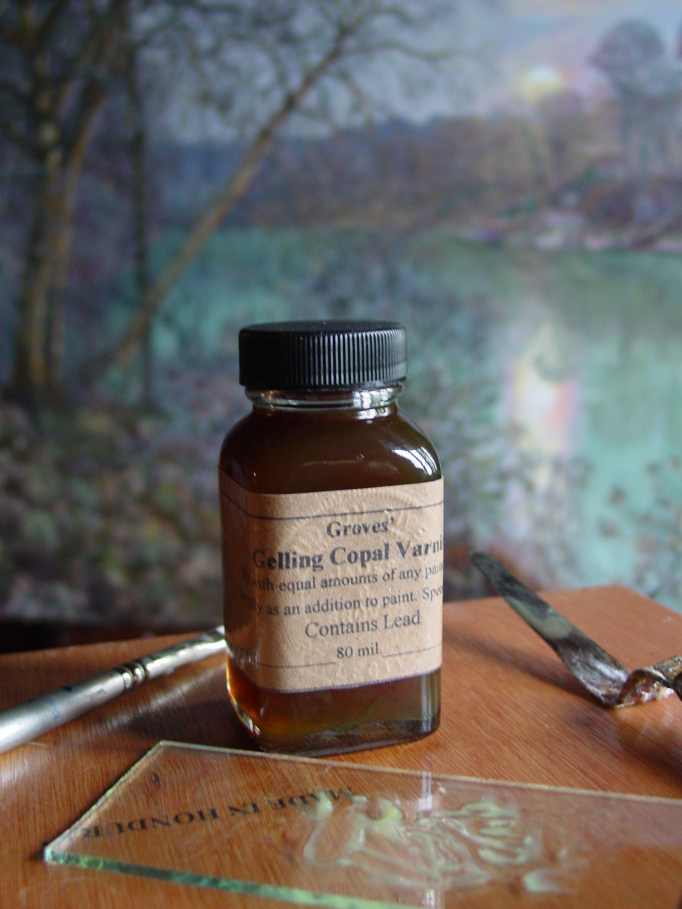
Gelling Copal Varnish - This varnish contains copal, turpentine, and walnut oil. The fast-drying version also contains a metallic-based (lead and manganese) drier. We recommend mixing this varnish with un-refined walnut oil when making a painting 'jelly' medium; or the varnish can be mixed directly with the paints on the palette, congealing them, so that they then require a solvent (such as turps, mineral spirits, spike, lavender, or Rosemary) for actual painting ( my own preferred method of painting).
GCV without the metallic (manganese and lead) drier allows extended working times, several days, but may be quickly 'pushed' to become dry by placing the work in direct sunlight for an hour; afterwards, the painting can be returned to the studio, whereupon it will likely be dried in about 12 hours or less. Of course, adding a drop of any chosen siccative (drier) to the paint, or using a 'drying oil' (such as "black oil") to create a painting 'jelly', will allow fast-drying, too.
For use in a solvent painting technique: Simply dip the clean knife or a brush handle into the jar of CGV and allow two or three (or more) drops to land on each paint nut. I recommend about three drops per nut. Use the knife to work the GCV into the paints, creating a congealed mixture. Then add a few drops of any chosen solvent and remix the paint into a supple amazingly facile texture, allowing brushwork effects obtainable in no other way. There is never a need for 'oiling-out' when using this solvent-added technique. The paint is further thinned for required uses (such as thin lines, tree branches) by lightly dipping the brush into a handy solvent while painting. This method works quite well with handmade paints, especially those that are slump-y. In fact, it is generally recommended to rub-up the freshly-made paints to a thin-cream consistency for best results when using congealing varnishes. Any paint-effect observed in the works of the olden masters, as well as up and into the 19th Century, can be hand in this fashion, which is through the use of a powerful congealing ('gelling') varnish.
For use in an all-oil-no-solvent painting technique: Many oil painters today have moved away from solvent-use, preferring instead an all-oil methodology in the creation of their work. Our amber, sandarac, and copal "gelling varnishes" work well with the all-oil manner. GCV combined with any painting oil creates a gel medium that strengthens oil paint and allows manipulation unavailable with non-gelling varnishes or straight oil-and-pigment paint. If the GCV contains a drier, its use with the paint also speeds drying (generally overnight). Additionally, using GCV increases color-saturation and optical qualities in the work.
Unlike megilp, no leaded drying oil (AKA "black oil") is required to mix with this pure copal varnish. Everything essential to gel-formation is already contained within this varnish. Just add an equal or double-amount of any oil desired and, voila, a pale translucent jelly medium is born. This 'copal jelly' couples a long open time with truly exquisite brushing and manipulation abilities ; and the medium, itself, dries water-clear and is very flexible.
Demonstration: Making a jelly medium with this varnish is easy and fast. All that is needed is a scrap piece of glass (about 4"x4"), a palette knife, and your own preferred painting oil. Put approximately equal amounts (exact amounts are not critical to performance) of the copal varnish and the raw oil upon the glass and mix well with the knife. A soft translucent thixotropic "jelly" is immediately created which performs absolute wonders with oil paints-- either comercial tube paints, or handmade. Mixed with the paint, a super-slick media is created that stands at attention, blends easily, and is typically dry and awaiting the next day's session-- allowing layering to be performed with safety. Facility is exceptionable; for example, thin lines or tree-branches can be painted without neeed to oil-out the area beforehand ; and there will be no diffusion afterwards.
In addition, the jelly medium can be made to the painter's whim. For instance, if you wish slower drying or slower paint-set, simply add more raw oil to make a softer gel ; and a thicker, crispier impasto calls for a firmer gel. The reason behind the exceptional performance is the copal jelly maintains stature while providing extra lubrication to the pigment; and so paint glides on effortlessly. [It should be always borne in mind that the more medium contained within the paint, the thinner the application of that paint should be....though use of this copal jelly --when based on walnut oil-- can go a long ways towards circumventing that rule.]
With use, the 80 mil. bottle of varnish will make at least 160 mil. of medium; and more if the painter finds preference towards a softer, thinner jelly.
The following images show the simple steps in using the varnish to make the jelly medium. No dipper cup is necessary to store the jelly while working. Instead, after creation, the jelly may be slapped onto the palette where it remans ready for need. [ Note: as of May, 2007, Gelling Copal Varnish is now concentrated to produce twice the amount of gelled painting medium.]
Raw oil on the left, varnish on the right.
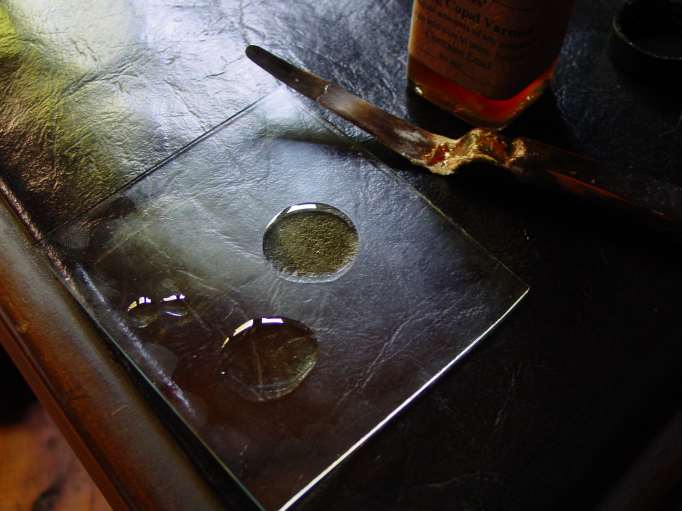
Mix and swirl the two liquids together and the jelly forms immediately.
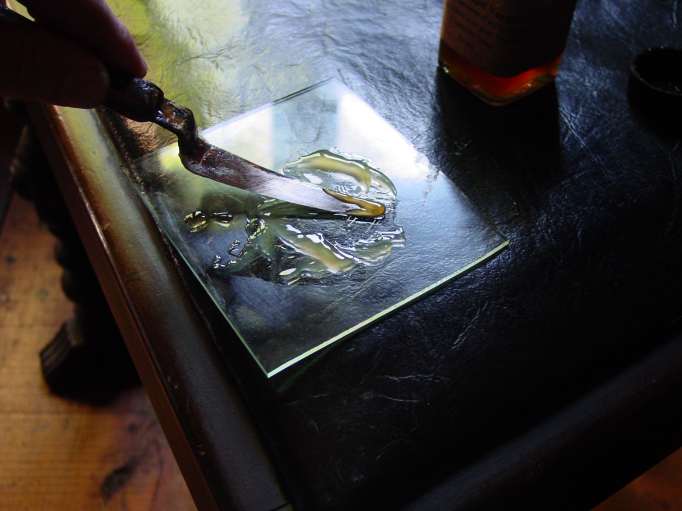
The copal jelly is ready for use with the paint.
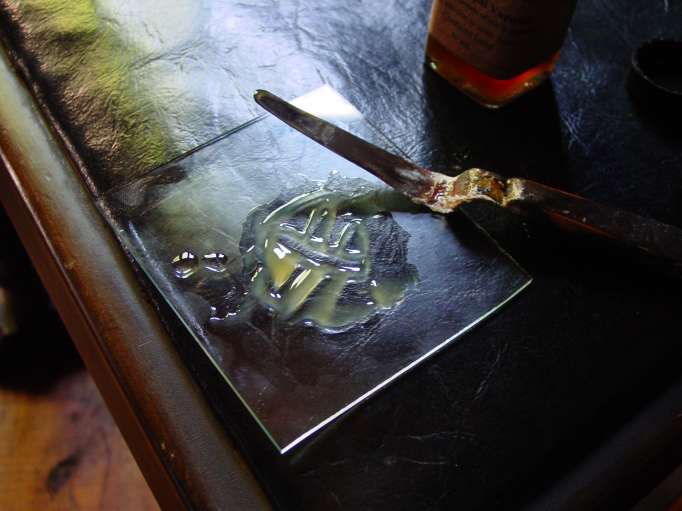
Note the two drops of oil that were not mixed with the varnish. Each droplet runs with gravity while the much-thicker gel remains steadfast.
In use, the jelly matter is like a liquid glass, in that it suspends the pigments and dries water-clear.
The following image shows the fully-dried and solidified "copal jelly" created on a small sample piece of regular glass. Notice the jelly remained perfectly upstanding through the drying process and with no wrinkling. The marks of the palette knife-tip are clearly recorded. Background Oil painters have always loved the use of jelly mediums. There are many who believe the most useful mediums of all are those that are gels. The reasoning is not difficult to follow. Gel your paint and all manner of executions/manipulations are handled with ease, that is, when compared to common oils that spread and behave according to gravity and their own physical attributes/limitations. This is why thixotropic gel mediums attract those of us who push paint. Apply the jelly upon a vertical support and there is no running nor dripping. The oil paint, from the thickest impasto to the thinned-down and richest of glazes, stays where it's placed. In short, every execution comes off wonderfully. Many painting experts today say all one needs is perhaps some oil and a solvent combined with a decent tube paint to create just
about anything imaginable with that paint. In fact, some get along fine even without the solvent added. Every painter should be happy with their materials. And if you are one who is happy with your materials and technique, there is no real need to read further.
Indeed, I fully realize many manipulations can be handled with such simple means. Yet some manipulations cannot; and, we should always keep in mind, modern-day tube paint almost always contains an amount of a gelling substance to help it behave itself ; i.e., aluminum stearate, hydrogenated veggie oil, beyond-micro-fumed silica, or several other agents and combos thereof. These gelling substances do supply physical character to the paint, keeping at bay some of that paint's inherent faults, which I can often agree is a good thing. But in no way do these gelling agents increase the binding strength of the oil. [Additionally, nearly all these types of mechanical gelling agents dry to form dull and visually opaque films. For example, fumed silica is actually used as a 'satin-izing' or flatting agent in modern-day laquers and varnishes. ]
Oil paint is not the tough creature that we might think. Raw oil as a binder is rather weak. It will remain a gummy film for many, many years until it completely evaporates away. The oil binder may also be weakened by some pigments it's mixed with. For example, any iron oxide red can attract water to the dried paint film (somehow, the pigment 'likes' water). That characteristic can lead to early paint-film failure. In any such case, the less hydroscopic the binder, the better the guard against this phenomena. A small amount of any oil/resin varnish will help to minimize the bad trait.
Also, aluminum stearate is a gelling agent in wide use today. This ingredient can make up a very large percentage of the paint -- even though, by weight, it is kept below 2% (the material is so light-weight, even a small percentage in weight can translate to a large bulk amount). AS is made from animal tallow; and it also weakens the paint film, making it more susceptible to humidity and oxidation. [Guard against your cat or dog 'critiqueing' your 'tube paint' work left leaning against a wall, for the remark will forever stick. BTW, efflorescence on dried oil paintings is quite common today. This effect shows as a whitish crystaline exudation/formation atop recent era modern painting containing AS and which paints have apparently been used 'straight from the tube', that is, without immixture with varnish mediums.]
Of course, heightened optical qualities and stronger paint films have always come from varnish-additions. And so, to answer these problems, modern suppliers offer alkyd varnishes to go along with the oil paint. Alkyd resin media are cheaply and readily available today and alkyd is touted to be a wonderful modern-day highly plastic creation. [Well, not so fast here! In fact, pure, straight alkyd resin is not plastic at all; it's actually very brittle. Made from a combination of pthalic anhydride and glycerin, alkyd resin needs some 'fatty' additions to render it plastic enough to be suitable for the painter's use. Now, raw copal is brittle, too (by contrast, fossil amber truly posesses a supremely tough natural plastic character. For example, if you hit some copal resin with a hammer, it will shatter nicely. Try it with amber, and your hammer is likely to simply bounce away). As I understand what I've read on the subject-- I am not a maker of alkyd media-- to make the brittle basic alkyd resin into a tough plastic critter, it is treated in the same tried-and-true historic fashion as raw copal; that is, the basic alkyd resin is formulated with various 'fatty' agents like vegetable oils to make it suitably flexible/plastic. Additionally, the so-called 'modified' alkyds are often given a good dose of pine rosin (meaning your synthetic alkyd may contain a goodly amount of a natural resin). As one might expect, formulations containing more oil or fatty substance give the alkyd-based media greater plasticity, making it suitable for, say, slower-drying house paints; and less fatty alkyds retain the inherent hardness of basic alkyd and are good for making polishable lacquers and baked enamels. Ergo, the careful mind will deduce that it is the combination of the brittle alkyd resin with fatty acid substances that engenders any plasticity. Likewise, copal varnish and copal media are made nicely plastic by combining the brittle hard copal with fatty agents. In our case, we utilize an oil with an excellent centuries-old track record for paint durability-- walnut oil. One can only wonder what fatty acid/acids the various alkyd creatures are formulated with....]
Anyway, alkyd varnish is offered to artists as a cheap immitator of the more-expensive, tried-and-true copal (indeed, tried-and-true-- just ask the Tate Gallery conservators who have recently studied the paint of the Pre Raphaelite painters). But as to "jelly" media, no one has yet found a method of producing a pure or modified alkyd media that gels oils; and so the alkyd varnish/medium is mechanically-gelled with the very same agents already noted for gelling oil paint. That's one way to get the job done but the too-often result of such use is sluggish paint-manipulation ; and, usually, a too fast-setting performance. [Some of these alkyd products are known to solidify in their bottles within weeks after opening. A good side: such media are usually cheap enough that one can afford to buy more.]
The copal jelly medium made with the GCV is quite similar in appearance and painting character to that controversial medium known as Megilp ( more info, see "Megilp" on our mediums page). Megilp was/is usually made by simply mixing some leaded oil (known 'back then' as "drying oil", but today as "black oil") with some strong mastic spirit varnish. The result was/is, within minutes, a soft jelly that enabled more manipulation with oil paint while it reduced tendencies towards running or spreading ; also, the mastic jelly allowed especial facility with the brush and faster-drying. Megilp held high favor with many painters in the mid-1600's and on up through the1800's ; but some painters had troubles with its use. It was said to darken and wrinkle the work-- either everywhere or in passages. Having studied the product through many years, I now believe these problems had much more to do with over-use in too many paint-layerings of the jelly medium, especially with those recipes based on linseed oil. In other words, my best guess is this medium is safest if made using walnut oil instead of linseed; and if the work is painted essentially alla prima, that is to say, working up to basic completion one section at a time atop a careful underdrawing, as Sir David Wilkie did when he painted his still splendidly-conditioned "Blind Fiddler" in 1806. It is well-known that Wilkie used megilp as his painting medium for this fine work.
Despite its long popularity among painters, megilp is not always the wonderfully seductive creature beneath the brush. Many painters using this legendary jelly medium (AKA "Maroger Medium") complain about the too-fast-settting time, which, as soon as the solvent flashes away from the paint-mix-- usually within an hour-- engenders a sluggishness to their paint and brushing/blending manipulations-- as well as producing a sticky and too-high-gloss finish at completion. These characteristics are not encountered with the jellies made using our Gelling Copal Varnish, which supplies about an 8-hour free-working window before stiffening; as well as a final soft sheen at drying. As for toughness, megilp was never known to be a strong media, and this was due to the need for a high percentage of the soft mastic resin in it's formulation. Reviewing the old formulae and discounting the solvent-- which would soon evaporate from the mix-- the typical megilp produced 33.3% mastic in the final dried film. Of course, this ratio would then be diluted down by the amount of oil latent to the actual paint it becomes mixed with. But, there is something I should mention in this regard. You see, to truly obtain the full advantages in optical and brushing effects inherent from this controversial medium, a strong dose of the mastic 'jelly' is requisite to the paint. My own trials with megilp show amounts often above 50% necesssary to deliver full ranging effects with this medium; and, no, a 20% addition of megilp to usual/regular oil paint will not engender the full glassy effects capable of this historical medium; that is, unless a thin coating of the pure jelly has already been applied as a couch; and, in which case, the amount of megilp contained within the final paint film may likely soar dramatically as the applied paint is joined with the pure megilp couch. [For those who maintain 20% additions even w/o couch as adequate: well, any effects garnered by that route will merely resemble those of a non-gel medium. In which case, why even use a jelly? As I say elsewhere, old master paint often looks well-dosed in glassy medium.]
Rather successful attempts were made to increase megilp's strength by incorporating some amount of oil copal varnish within its formulation. This type product was usually termed a "copal megilp". One such critter held in particularly wide favor was "Roberson's Medium", a 19th Century English concoction of a leaded copal drying varnish compounded with regular megilp and a bit of oil of spike. According to the 2004 Tate Gallery-produced book, "Pre-Raphaelite Painting Techniques", strong evidence was presented that oil copal varnish as well as Roberson's Medium were likely utilized in just about every one of these famous British painters' productions-- and with mostly dependable and durable results. Interestingly, these British painters not only used the varnish within their paint but often finished their work with a final coating of copal varnish; and in some cases, these coatings are still doing service after 150 years*-- a remarkable performance to ask of any final varnish. It is quite apparent, based on this book-- a book produced by Tate Gallery senior and head painting conservators (J. Townsend, J. Ridge, S. Hackney, along with input from Canadian Conservation Institute's L. Carlyle)-- that copal varnish and combinations thereof with oils or otherwise 'weak' mastic-based media does produce durable excellence within oil painting. [*Note on Page 74 of " Pre-Raphaelite Painting Techniques", the conservators write: "Because of the glossy original surface of their paintings, it was possible to apply a varnish thinly. Thin varnishes appear less yellow than thicker ones and will have lasted much longer. The temptation to remove a varnish from a Pre-Raphaelite painting is therefore much less, and the leaching of the paint film by solvents is accordingly avoided. Some of these paintings have not been cleaned (which is rare for a work 150 years old) and have old varnishes that are quite degraded though not visually disturbing."] Copal varnish and oil painting
Now about copal: I provide much info regarding this resin within the product-report for "19th Century Copal Varnish" listed on our mediums page. Copal was almost certainly no stranger to the artists before the 19th Century. Every household had some oil varnish on hand for daily-use with the various needs of life. I understand some even used it as a medicine, either drinking it or applying as coverage much as we do today with petroleum jelly. To think a practicing painter would not chance to try this on-hand varnish with his oil colors is, well, not in character with any artist deserving of the name (artists will try anything at least once....and, of course, some manuscripts dating from way back to the 1400's do mention tempering the oil colors with varnish before use). There were many resins utilized in early varnish-making ; and good, tough copal must surely have been one such.
Varieties of copal
Below: Hymenaea-type tree-derived Congo copal from West Africa; very light in color; could be hundreds-to-thousands of years old; dug from the ground, often found in very large lumps; mostly originated from the enclosed bug or rodent-hollowed tree stump; favored in the 20th C. as a varnish coating; said by some to be the toughest varnish-maker, although my own tests fail to support this notion. -- collection of Western Maryland Gallery
Below: Hymenaea-type tree-derived Sierra Leone "pebble copal" from West Africa; frequently forms in odd little balls, massed together; dug from the ground/found in stream beds; when taken from its storage jar this sample has a tendency to fissure and separate into balls and clumps, indicating it is likely younger in age than the Congo. That thinking aside, I still believe it is at least a century old, for the varnish created is every bit as effective in congealing character as the oldest copals I've tried. The ball-like condition may indicate an origin from intermitant drippage in tree and limb-cuts/hollows; said to be the favorite of 19th C. English painters-- collection of Western Maryland Gallery
Below: Hymenaea-derived Santander copal from Columbia, South America; very light and probably very old; hundreds-to-thousands of years burial; originated from the enclosed termite-hollowed tree and stump. Excepting each resin's outer physical appearance, I can detect no difference between Santander, Sierra leone, and Congo copals when made into varnish-- collection of Western Maryland Gallery
Below: Hymenaea-type tree-derived Madagascar copal from East Africa; said by supplier to be recent to hundreds of years old; darker, cloudier appearance and shape infers formation on outside of the tree. This resin makes a darker varnish compared to other hymenaea copals tested, all of which produced rather light and clear varnishes with our best procedure. Still, and though a darker varnish, it was quite useable and resulted in a very tough coating ; however, the constructed varnish-- when added to paint-- produced 'soft' paint-character and lacked the immediate congealing capabilities found with the much older hymenaea type copals. I have also noted this 'soft' character when making a varnish using fresh-off-the-tree Hymenaea copal. Thus my guess is this Madagascar is rather young in age-- collection of Western Maryland Gallery
Below: Agathis Auracaria pine-derived Manila copal from Indonesia; light and clear, best quality; originated from the tree bark as freshly-collected drippings; termed a "soft" copal but makes a very tough varnish. From my readings, I gather the Agathis type copals were favored by 16th thru 18th+ C. Italian craftsmen. Agathic pine copals seem to help the oil-solidification of most oil paints while most regular pine resins slow the drying of oil paints-- collection of Western Maryland Gallery
Below: Agathis Auracaria pine-derived Pontianak copal from Indonesia; mixture of dark, cloudy and light yellow-clear pieces; Like Santander, this copal is classifies as semi-fossil; likely originated from the outside and inside of tree. May have been dug from the ground; same tree as Manila but resin is much older and tougher to dissolve into oils; same toughness but noticeably greater gelling and drying effects than hymenaea Columbian Santander. Pontianak has become my favorite resin for constructing excellent artist's Copal Varnishes.-- collection of Western Maryland Gallery
The above are samplings of some varieties of Hymenaea-type and Agathic copals which have a long history of use within oil painting technique. Though botonists have for many years classed the parent pod-bearing trees variously, I prefer to simply label them all as "Hymenaea-type"; and the reason being that when heated or cooked, my nose tells me these resins come from the same basic tree. The Agathic pine copals share a different heated smell that slightly changes through aging. Comparing these two types of copal as varnish-making ingredients, my own longevity tests show the various Agathic and Hymenaea types * all perform with excellence when made into oil varnishes; there has been no apparent darkening or yellowing of the dried films placed in humid darkness. I might assume these copal varnishes will perform every bit as well as those copal varnishes in use by so many great painters during the 19th C. (and earlier). I can easily suspect the numerous claims made saying copal varnishes always turn yellow and brown were likely fostered through varnish recipes containing high levels of linseed oil -- there are 19th century recipes calling for up to seven parts linseed oil to one of copal. Such linseed-heavy varnishes will display all the faults of linseed oil. It is small wonder that some painters, like John Linnell, decided to make their own copal varnish. [* Note: my own varnish recipies were constructed at very high temperatures using equal amounts of copal and walnut oil. No yellowing tests have been made using the Madagascar copal in a varnish; however, I'd also suspect it to perform in like manner to the other Hymenaea varieties.]
Copal from where...?
Essentially, there were three types of copal available to oil painting throughout the last 600 years. Burseracia, Auracaria Agathis, and Leguminosae-Hymenaea.
It is a given that we painters will desire the hardest and brightest copals with which to make our varnishes. That granted, the first type of copal can be made into a varnish rather easily, as it can often be dissolved in nothing more than turpentine. Variously known as copal, I should mention this type of resin is more correctly known as gum elemi. Because of its ease in turp-solvency plus very light appearance, Berserus-type copals were a common choice for easily-made light and clear copal picture varnishes in the last century.
In stark contrast to the easily-solved Berserus copals, the latter two copal-types are difficult of solution; and usually require fusing before they will combine with oils. Though darker in their resulting varnishes, I have great faith in these two 'harder' types of copal. Why? Because they have been in use by painters since the earliest times; plus, they show great strength with no noticeable yellowing when properly combined at extremely high temperatures with walnut oil. [Oil varnishes are neither resin nor oil. They are a molecular combination that alters the properties of each ingredient ; and, from what I can tell, the new product is much superior to either faction, alone.]
Both these tougher copals -- Auracaria Agathis and Leguminosae Hymenaea-- were available to Europe from about the 1300's on. They arrived through trading and originated from the East coast of Africa as well as the Far East and Indonesia. A bit later, with the discoveries in the New World, copal began arriving into Europe from the West Indies and South America. Mayerne actually mentions copal in his early 1600's manuscript. These New World copals would be likely more of the Hymenaea types-- sometimes designated 'anime' because the lumps often contained encapsulated bugs and vegetative matter. Because these resins were commonly available, I have little doubt oil painters-- like the Dutchman, Cuyp-- would have used either Hymenaea (African or South American) or Agathis (likely manila-type copal gathered from the Maldives, a group of islands southeast of India). Copal from the West Indies (Hymenaea) and East Indies (Agathis) became increasingly popular during the 1700's while amber fell out of fashion, diving into relative obscurity from use. Finally, in the 1830-40's, large amounts of the copals from Africa's West coast began to have a role in varnish-making. Though variously attributed to other-named tree-sources, my nose tells me that these particular west African copals were also mostly from pod-bearing leguminous trees-- the same type of tree as those previously being obtained from South America, though some makers touted these new finds superior to all others of favor. The new copals were named according to their exporting locations. Thus, we have the copals called Congo, Sierra Leone, Accra, and Gaboon. Britain seems to have favored most of these African leguminous copals; and, as a curiosity, their varnishes were said to be the finest in the world during that golden time-period. [ I might add, from my own readings, copal seemed especially favored in Italy during the 1700's and on up...and perhaps well before...?]
Detection of copal varnish in the old paint
As noted elsewhere within this site and this report, the known-use of copal varnishes within 19th Century oil painting technique produced certain desirable effects with the paint and its manipulative accents. Importantly, this use of copal has caused no harm and apparently allowed a certain bump in optical effects-- as well as maintaining excellent longevity to the works.
While it is true there are very few findings of any copal varnishes in the old works-- the 19th C. included -- know that, until very recently, there were no analysis techniques capable of actually detecting the high-temperature-made oil varnishes. This was the surprising finding when some mindfull researchers at the Canadian Conservation Institute actually constructed a true copal oil varnish then put it to the test with their state-of-the-art GCMS analysis technique. The result: no copal 'fingerprints' showed. Apparently, the high temperature involved during construction of the varnish destroyed the copal resin's markers. And so it seems all those past scientific findings maintaining the old masters never used anything more than oil and pigment are based on tests not actually capable of detecting oil varnishes.
In fact, only within the last 4 years* has an alternate technique been developed that could 'sniff-out' trace copal effects in a normal hi-temp oil varnish ....but that testing was performed on a fresh and pure sample of the varnish-film; and so the jury is still out as to whether the miniscule amount of an oil varnish hidden in an old paint chip would even betray itself. There have been findings of copal and other resin fingerprints in old varnish coatings. But these rare findings more likely come from low-temperature-made varnishes such as spirit-types where the resin is dissolved in alcohol or spike which require little or no heating in formulation -- and these being more likely applied in purer concentrations as final protective coatings atop the olden paintings. These solvent-type varnishes do not otherwise harm the latent 'fingerprint' or 'markers' of the resins used; thus, finding them is rather easy. This is not so with the high-temperature tough oil-and-resin type varnishes. [*Update December, 2005: the new and promising testing technique failed to find copal in numerous paint chips taken from known-to-be-painted-w/copal works by the 19th C. Pre Raphaelite artists; see "Pre-Raphaelite Painting Techniques", published 2004, Tate Gallery, London.; author Joyce Townsend et. al.; page 78 and appendix. Writes senior conservationist Townsend: "One aim of this research was to develop analytical methods to recognize copal-based media. While improved methods of analysis have been developed for copal, it became clear that promising samples from Pre Raphaelite paintings were still posing an analytical challenge: it was very difficult to show that it was present where it had been expected." Not finding the 'state-of-the-art' GCMS markers for copal, Townsend and her fellow conservators went through the 'back door', so-to-speak, looking for other signs of oil varnish use. These other paint-chip attributes were: signs of heat-bodied oil (with GCMS analysis, highly-cooked resin-oil varnishes show only markers of heat-bodied oil), a strong fluorescence under ultraviolet light (resins and resin-oil varnishes strongly fluoresce, while oils, alone, glow weakly), refractive indexes of the actual paint comparable to additions of copal varnish media (the Tate group wisely constructed their own copal medium and tested that thoroughly for refraction qualities), plus-- big, big item-- the letters and notes of the painters, themselves, as well as their colormans' (Roberson) purchase ledgers-- ledgers which plainly showed nearly every PRB painter purchased copal varnish or copal media during the general time-period of their painting performance. Amazingly, a few of the PRB painters sometimes daubed their frame-hidden canvas-margins with copal-based colors-- actually penciling in the descript. Well, so much for those scientific proclamations about not finding resin-oil varnishes in old master paint chips using GCMS analysis. How could they, really, when comparatively much fresher paint-samples known to actually contain copal varnish/medium fail to betray themselves-- even with the latest hyper analysis techniques? ]
"Jelly mediums" based upon copal
As noted, copal has been an ingredient in megilp for well over a hundred years. As with all these "copal megilps", the aforementioned Roberson's Medium utilized mastic as the gelling agent and copal varnish as the fortifier.
But it seems no one has been able to get a pure copal-and-oil-only varnish to gel oil of and by itself; that is, alone, without the need for mastic or other gelling agent.
As example of then and now-current thinking, I'll supply an interesting quote from the aforementioned Tate book on PRB painting techniques:
"Megilp was very popular, but it was held to be a 'weak' material with a tendency to darken. In 1835, it was recognized that it was a 'desideratum with the artist to form a macgilp [sic] of copal, which would stand up with the flimsy firmness of that of mastic' (meaning, it should be a soft gel with a thixotropic character-JCG). Sometime in the 1840s, Roberson appeared to have achieved just that; however, a study of that recipe indicates that they produced what was essentially a megilp with copal added. In fact, it is not possible to achieve a gel with copal varnish and lead-treated oil alone: mastic resin is essential, as recent practical experiments have shown."* [* see page 49, "P-R Painting Techniques" 2004. For much better historical coverage and insight, see also George Field, "Chromotography", 1835 (reprinted 1841), pages 341to 376, wherein Field supplies a painting vehicle composed of copal, turpentine, and some drying oil. To this mixture Field recommends adding, "about an eighth of bee's-wax [which] will enable the vehicle to keep it's place in the manner of macgilp."]
Be it known, Roberson's Medium called for strong mastic varnish to be mixed with drying (leaded) oil and a drying copal oil varnish in proportions equal to 33.3% each of mastic resin, a weak-in-copal drying varnish, and leaded drying oil-- this being after solvent flash (which included a dose of spike oil). Yes, this is obviously a copal megilp, in that regular megilp is most often composed of 1 part mastic and two parts leaded drying oil -- again, this after solvent flash. [BTW, anyone wishing to substitute our regular "19th Century Copal Varnish" into the Roberson's formula do pay heed: you must mix the pure varnish with two parts drying oil in order to obtain the apparent strength of the original copal varnish utilized by Roberson. Our varnishes are way too high in copal-content to be utilized straight as a 33.3% addition. However, another simpler route is to take 4 parts drying oil and add one part of our copal varnish; then use this mix in equal amounts with your strong mastic varnish (AKA, "double mastic" varnish). That mix will do nicely.]
The impossible dream ...
And so, it would appear that, historically, there were no known pure copal jellies available-- at least on a commercial basis; and, interestingly, this long-sought goal/idea, i.e., that a gel could be produced using only copal and oil, is still regarded as impossible-- leastways so in the minds of the Tate Gallery conservators.
Of course, the ability of copal to hold brush-strokes is well-known. Our own 19th C. CV and 19th C. DCV varnishes
exhibit this ability in spades, making them especially suited to mixing with large proportions of other agents while retaining this ability. It was this congealing or "freezing" trait that initially provoked my curiosity and prompted my own search for a method and means that would allow an amber or copal varnish which might actually 'freeze' painting oils and form a gel. Again, there are no known historical recipes that mention this gelling ability of copal-- at least not in any of the old manuscripts I've read. As substantiated by the PRB book quote above, oil painters were seeking a copal-based jelly during the 1800's. Yet, all such 'successful' recipes found in the old handbooks merely show mastic, or wax, or other, as the gelling agent. [For instance, citing again, Field wrote that a bit of wax would help his copal varnish-and-oil-medium to "keep its place in the manner of megilp".]
Well, in any case-- and regardless the historic and contemporary unsuccessful trials to obtain it-- we've now produced the unique and long-sought genuine article. There truly is such a thing. Our unique Gelling Copal Varnish produces a thixotropic jelly when mixed with oil. The actual gelling is produced by the copal ingredient; and not by some other gelling agent.
Historical painting Jellies How far back in history can we trace the recorded use of a gelling medium by oil painters? Rather far. Sometime around the year 1680, while visiting Italy, an Englishman
named Henry Tilson came into contact with one Sebastiano "Basha" Bombelli. Bombelli was a portrait painter of high regard in his day. Tilson noticed Bombelli working away with an odd white jelly, especially noting that Bombelli tempered all his colors with the stuff, utilized it in his first and second layers; and then finally as a glazing and veiling agent to finish off the work. Tilson inquired about the medium and was told the jelly came from Bombelli's own color-maker. Bombelli claimed the medium kept his colors from sinking-- a valuable trait. Tilson found it remarkable in the way it helped the flesh in B's portraits. The well-known portrait painter was even helpful to the point of giving a general direction for making the jelly. It turned out to be a cooked combination of mastic gum, walnut oil, peter oyl, and litharge. Going by the formula, it is seen that Bombelli's white jelly medium was based upon mastic resin ; and, as
such, was an early cooked form of the soon-to-be-oh-so-popular megilp, which many experts
today decry as a certain agent to a darkening and wrinkling disaster. [It certainly would be interesting to catch a modern-day look at a period Bombelli "in the flesh", so to speak ; and then we might see what if any disaster befell it. Curiously, there is an early mention from Luigi Lanzi -- an 18th C. Italian archeolgist and painters' biographer-- who wrote that some of B's works had become surface-obscoured due to a particular varnish the painter was fond of using. Lanzi mentions Bombelli also used this varnish on several other old paintings with the same result. We are left to wonder if this varnish may have been Bombelli's jelly vehicle. I shall add that I do believe a mastic megilp based on walnut oil could be quite lasting. And Wilkie's well-known 200-year-old megilp-based "Blind Fiddler" certainly offers excellent proof that megilp can be a sound medium. The equally well-known English animal-painter, Sir Edwin Landseer, was also a fond user of mastic megilp, and his paintings are still in good shape. Further, several Tate Gallery oil painting conservators have noted instances where 1600's paintings constructed with the earlier type megilps appear to be better lasting than some later works (see "Turner& His Contemporaries; Their Materials, Practices, and Opinions", by Anna Southhall, Conservation Department of the Tate Gallery, London, 1995, page 16. My thanks, as always, to the painter James Morton of Columbus, Ohio, for sharing this Tate Gallery article).] But there were other jelly mediums before megilp. How can I know? I have eyes and a lengthy background in oil painting ; and it is not a difficult thing to
see, really. Did you ever notice those very oily-looking juicy passages in, say, Frans Hals' clever works? There are delicious-looking passages that should have dripped down the panel or canvas ; and yet there they set, as if cast in a liquid glass. Charles Eastlake noticed brush-marks in the liquid glazes on some early 1500's Italian paintings he'd examined. He wondered if the Italians had some secret media similar to megilp to allow such freedom and paint-wizardry. On page 56 in the 2nd volume of his masterwork, "Methods and Materials...", Eastlake wrote: "...On the other hand, in pictures where the shadows are painted with much vehicle, the marks of the brush are sometimes visible in the transparent mass." Eastlake adds: "Whether the older painters had any other special means of arresting the flow of the colour in the cases referred to may be a question : the advantage of meguilp in this respect will always render it a favorite vehicle, notwithstanding its defects; but there is no evidence whatever that the old masters used it."
Of course, the oil painting experts of today caution us not to add much media to our paint; and yet we can readily see
the older guys' pigments were often and seemingly swimming in the glassy sauce. How so could they get away with such things while we of today cannot?
It is such simple observations as these that engender the thoughtful eye and mind to seek the "Holy Grail" of oil
painting media. [Note: I have read lately of a "newfound" theory allowing that finely-pulverized glass is surely the means to the brilliant optical effects attained by the golden age masters. This is not possible. The simple reason is, powdering glass to a pigment will effectively produce a pale translucent white paint when combined with an oil or other paint -- in overall effect, no better than pigment-grade chalk ; and this white ingredient, were it contained within every color and non color, would, as strong example, effectively destroy the deepest darks so characteristic to the olden paintings. What I mean is, mixing such powdered glass with a black paint, for instance, would produce a dark grey, instead of a black. And adding some of this powder to brilliant light colors will actually dull their saturation. The apparent real reason for this glass powder showing up in the old paint chips-samples is simply explained by the period manuscripts which mention adding pulverized glass to paints as a drying agent -- the glass used containing lead or other metal-- which did and does, effectively, speed the drying of the paint. There is another plausible rationale: that of the period color shops also cattering to ceramic and pottery craftsmen, who desired glass as an additive to the pigments so that they could create glazes for their fired wares. I can easily imagine some poorer painters asking for the adulterated colors on occasion to save a coin ...perhaps even the color-shop man selling the adulterated stuff unbeknownst.
As to obtaining illuminating glass-like effects, according to my own searches, only a resin varnish will allow the brightest and darkest saturated values/optical effects-- what I might easily call the 'liquid glass' effects. Of course, there are just too many ways to make resin oil varnishes. Copal and amber oil varnishes are not all equal. The final properties of the oil varnish depends on the ingredients, the ratio of these ingredients, and the total processing that combines them. As the actual amount of resin oil varnish utilized will necessarily be scant, do remember the overiding ingredient towards attaining the brightest optical effects must necessarily depend upon the oil binder used in the paint and medium. For this purpose, go for that least-yellowing time-tested ingredient known as walnut oil, especially the unrefined product.] But yes, indeed, one can see the very effects of a jelly media still standing in some of the olden works.
Was it some form of mastic megilp ...or was it something else? I have constructed some few varnishes that possess this gelling effect when added
to oils. And I firmly believe that if I can find these curious concoctions, those who arrived on
this planet well before me could very likely have done the same. It is my further belief that just
about any decent natural resin can be used to create such a gelling varnish. It is plausible some
few of these constructs might deliver valuable traits to oil painting. I'm thinking a fine copal
varnish just might be the very critter to match the need. Well... who can really say? Not I! Again, aside from using wax, the only other gel medium revealed by written word down through the last
three hundred plus years is that item based on common mastic spirit varnish mixed/cooked with
leaded oil. I suspect the reason for this is that the older gels were-- as I well know them to be--
difficult of construction. Painters who constructed their own varnishes may well have found and utilized these peculiar versions-- certainly the olden works show effects typical to the 'jellies'. But, later on, artists became slowly dependent upon the color shops for obtaining varnish. This would engender the take-over and use of commercially-made coating varnishes, which were not constructed to gel or meet specific needs of oil painters. [Still, the jellies based on mastic were quite easily constructed from readily-available basics like mastic picture varnish (which was sold everywhere from about the mid 1600's)
combined cold with the then-commonly-sold drying oil ("black oil"-- painting oil cooked with lead).] The Following small study is performed on glue-sealed heavy paperboard. In this example, no solvents were utilized (though I often do make good use of such agents). This scene represents an imaginary foothills composition undertaken in the grand landscape -- Hudson River style-- manner and technique. The first image shows the quickly scrubbed-in multichrome using YO, ULT, IR (iron red), with some white added to each color; and the basic brown seen throughout is lampblack+IR+White. My white is 75% lead white and 25% zinc oxide. All my paints are made by myself using pigment and raw unrefined walnut oil, rubbed together to a heavy stiff-cream consistency. Afterwards, lots of copal jelly is used in the handmade paint -- about 50-100% to bring it to a soft supple richness. I also oil-out the sealed dry ground with the copal jelly. My brushes are small soft Taklon flats and filberts, nothing over 1/2 inch-- sable and minever would be the original brushes for this sort of work. Though the paint is juicy, due to the jelly it is also steadfast in character. I often grab more jelly with the brush to mix with the tints as I worked. The effect is one of solidity with transparency combined. Everything keeps its place beautifully and allows going back over and refining while wet, either 'building' paint, or jotting and pushing/pulling with the various brushes.
The final scene measures 14"x18" and took approximately 2-1/2 hours (and a tea break) to complete. Oh, I did add a few touches of cad yellow + white in the more sun-lit area, left of center. As is my usual practice, the sky was left bare at this session-- simply the white paper ground left showing.
Next morning, everything was dry; I added some ult+white sky-color and clouds; plus some snow to that mountain in the distance. Also scumbled some very thin cloud-shadow color over the distant hills to make them recede. The jelly medium allowed everything with ease.
Two days later I sat down with fresh paint (same colors) and brushed on a thin coating of jelly to some areas. I then worked into the jelly, heightening color a bit and adding detail atop the dried underpainting. Realism built everywhere I worked. This final shot was taken out doors for truest color.
Realize, in making this painting, I used much more jelly than the "20% rule" being touted by so many experts today. You see, a mere 20% bit of medium added into my stiffly-ground handmade paint is simply not enough to engender the desired application abilities that I normally seek. For instance, I'll easily add 100% or more of my jelly to lamp black. My yellow ochre usually requires about 50% jelly to make it perform as I wish. Ditto most other colors. Really, how much medium I add depends on the character of my rubbed-up paint. Also, I usually pay only slight attention to the fat-over-lean rule and, instead, keep my layers pretty much equal in medium-amounts throughout the work. Resin varnishes allow this ability.[ Though, bear in strict mind, I'm talking walnut oil-use here; and not linseed. I'm sorry to report/warn, linseed oil will not allow the same lee-way.]
When it comes to the final glazing/veiling/ heightening layer, I will typically go medium-heavy. Some might get squeamish reading this, as it also goes directly against what is being preached today to young painters. Yet, in reality-- which is the realm we must live in-- this medium-rich method works perfectly. You see, what happens is this: much of my medium will necessarily sink into the previous layers. It's true; and so I give my last layers a strong dose of medium which allows the work-- after this sinking effect occurs -- to retain and exhibit a pleasing sheen; and also possess the optical richness and lasting durability which my strong medium allows. Were I instead to take the advice of the current oil paint guru's and have used "pure", or "pigment-rich" paint, and worked a thin layer of that starving creature over and atop my underpaint, the suction of the lower layer would then steal the scant oil within that thinned out glaze/scumble. Understand, such a glaze/scumble will have no real lasting strength; nor will it appear rich in optical effect; for it is, in reality, little more than powder brushed out atop your painting. Even the simple act of varnishing it some months 'down the road' will lift such poorly-bound glazes/veils. BTW, in no way does this weakly-bound 'powder-application' match the old master painting term known as 'glazing'-- literally meaning a layer of glass-like paint.
As with all our unique products, Gelling Copal Varnish comes with an instruction sheet to help with use.
James C. Groves March, 2005
Click here for online ordering
Click here to visit our Gallery page.
Click here to visit our Mediums page. 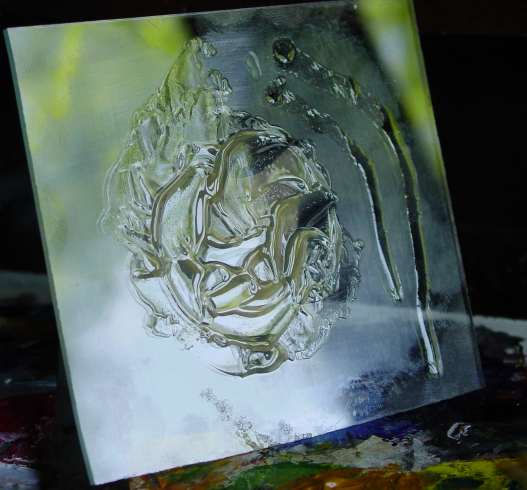
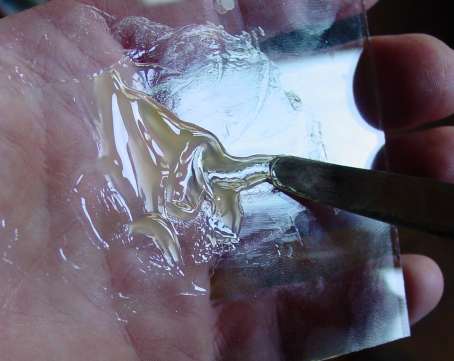
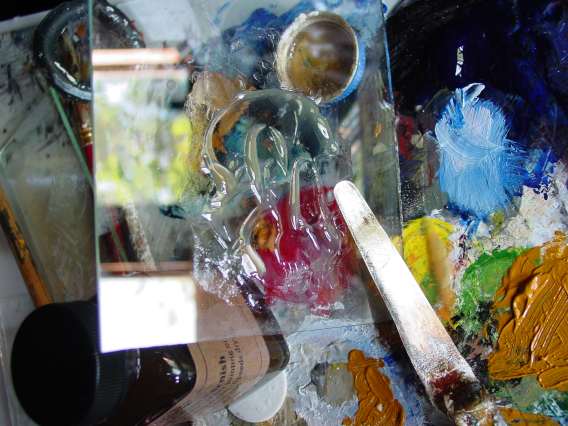
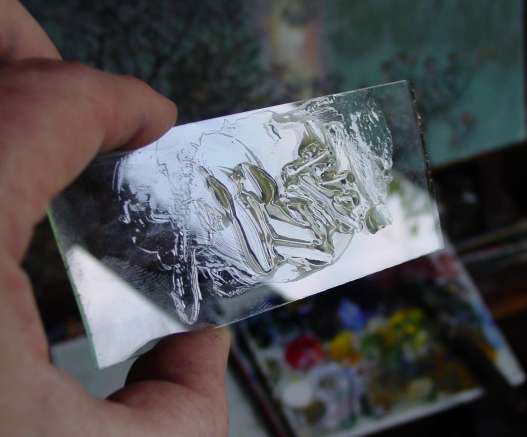
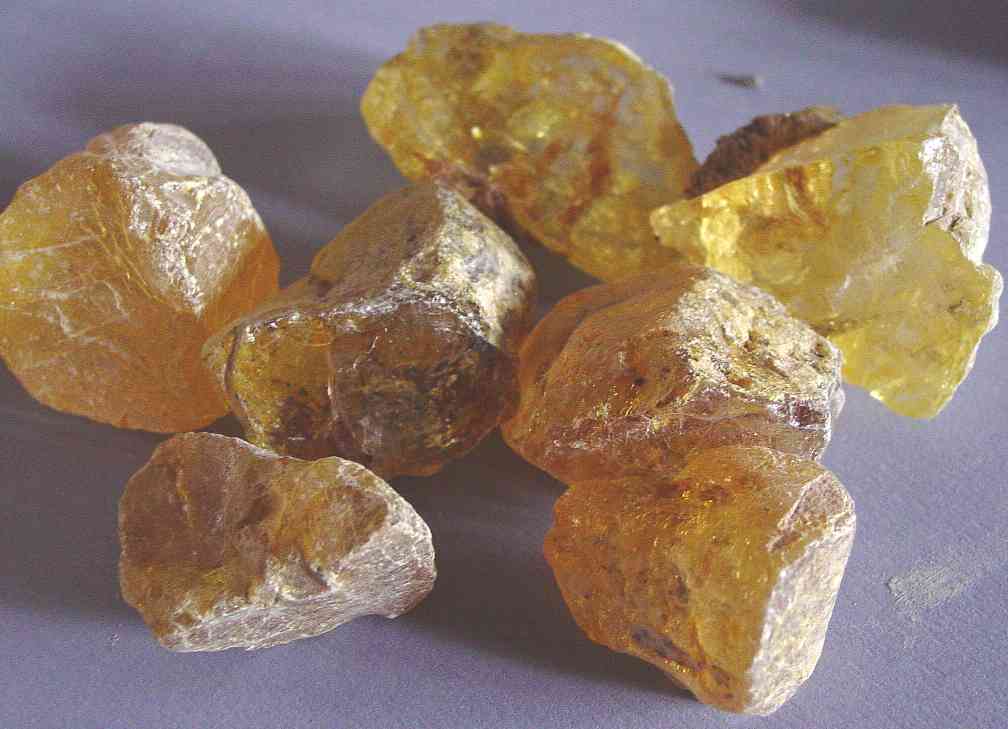
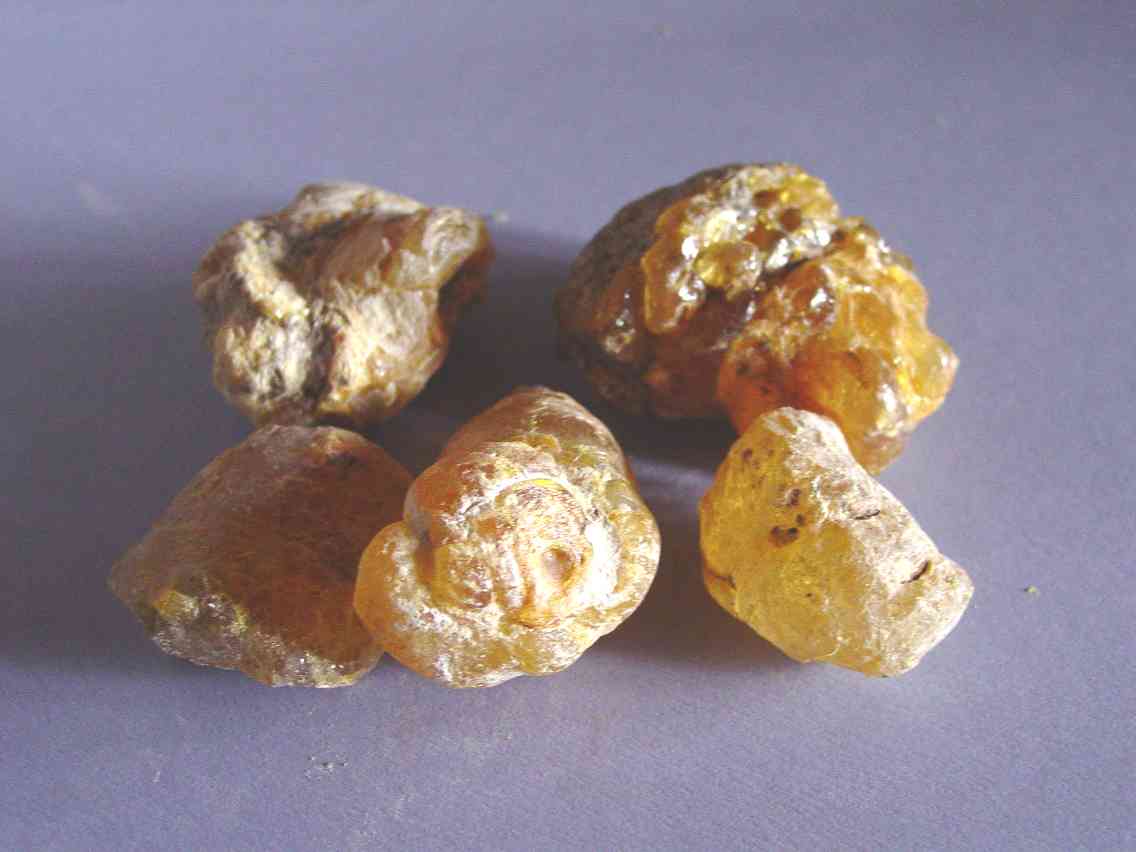
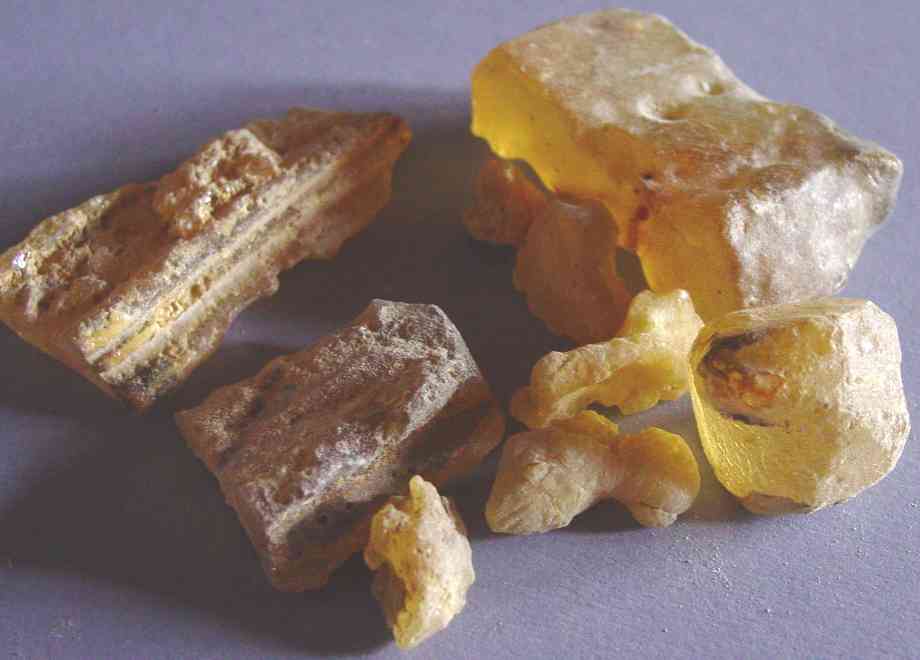
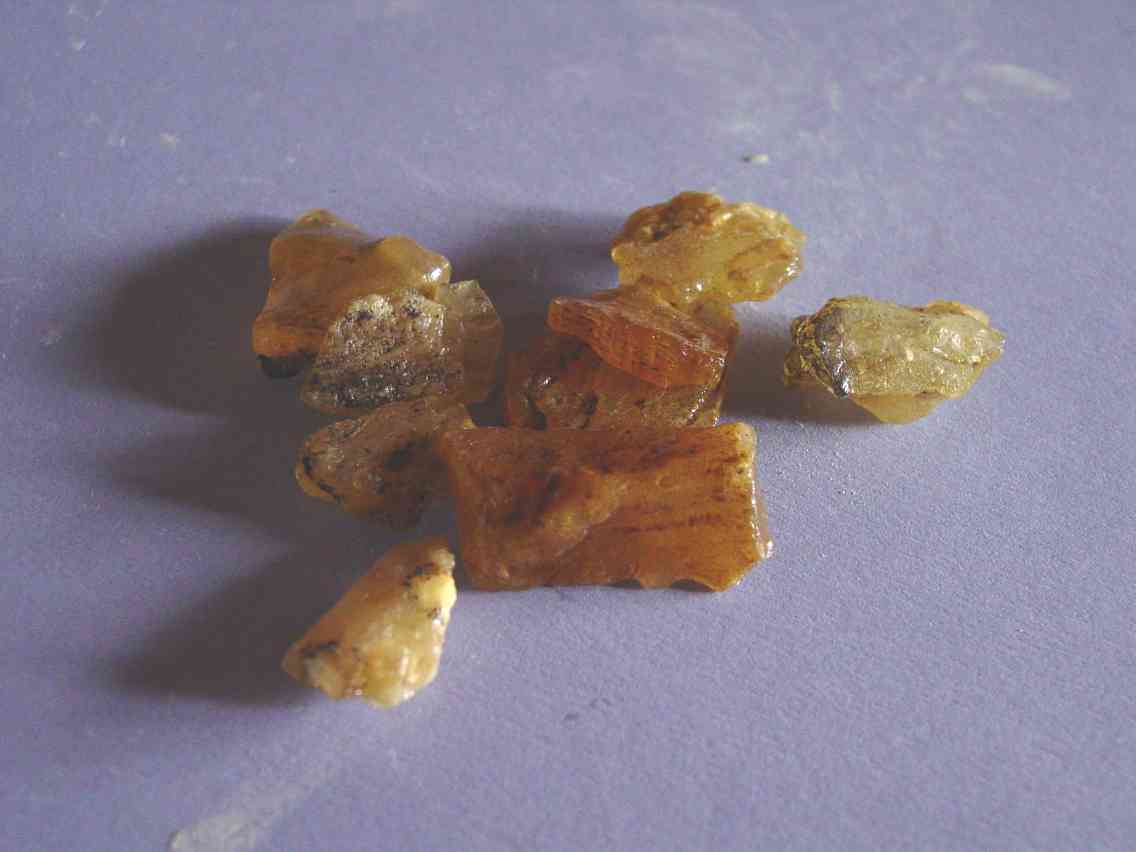
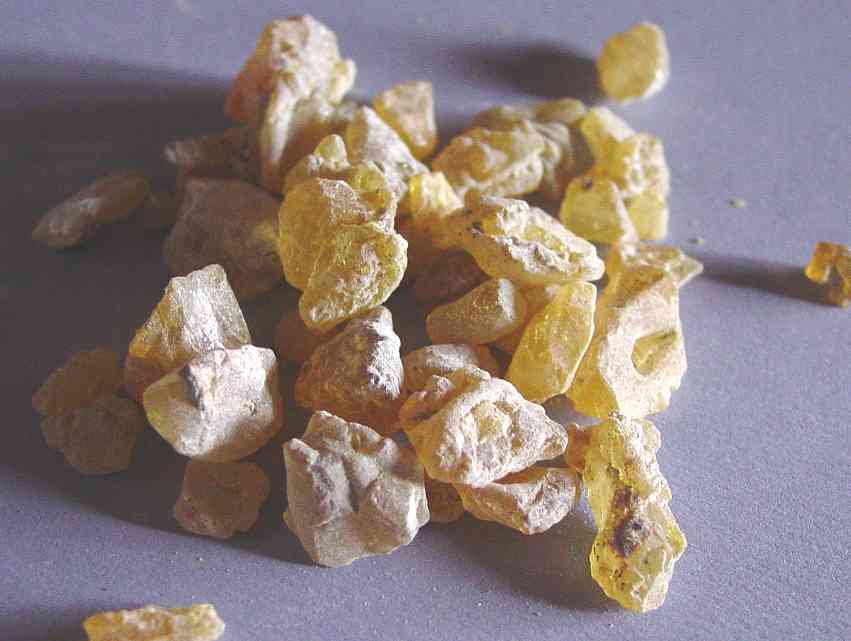
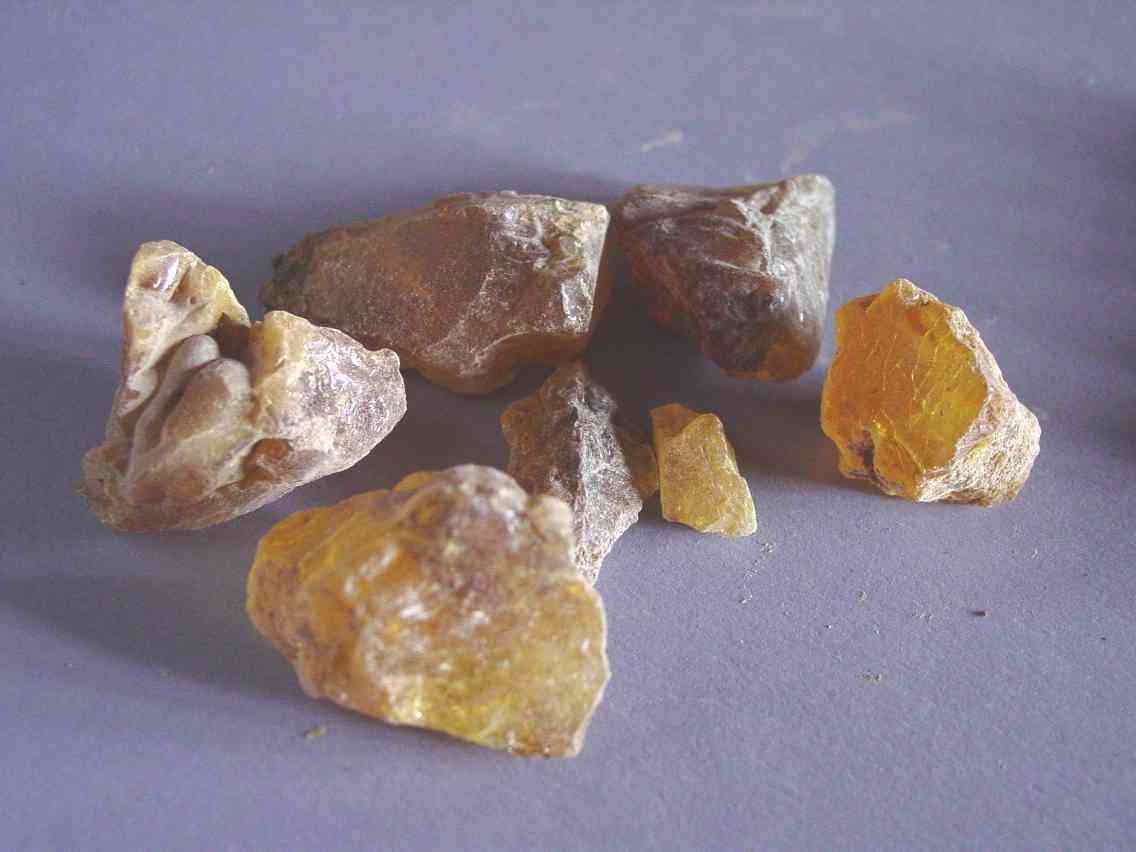
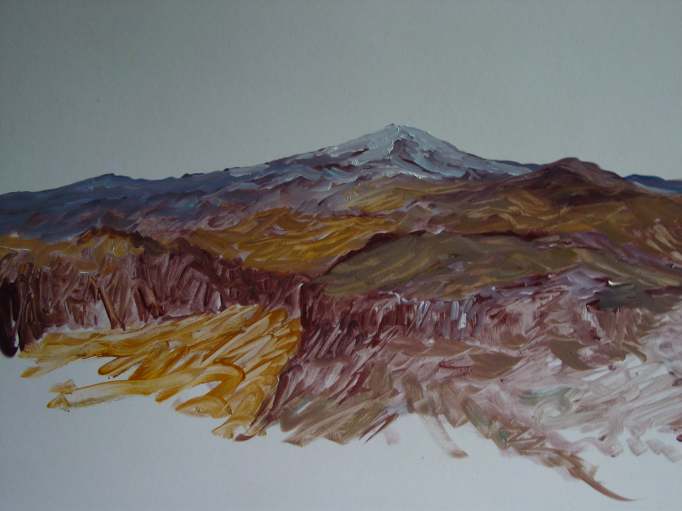
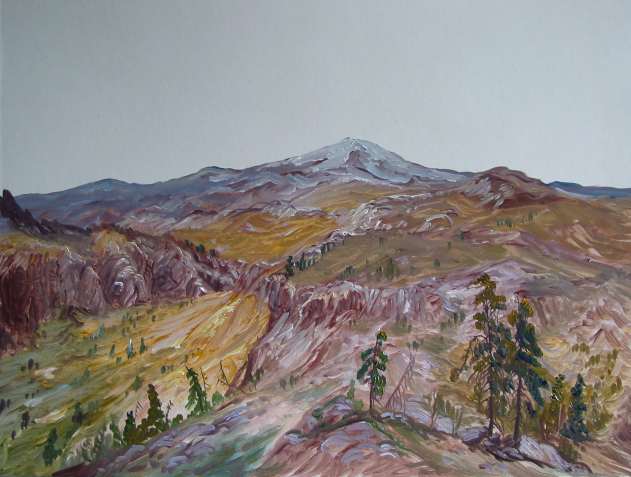
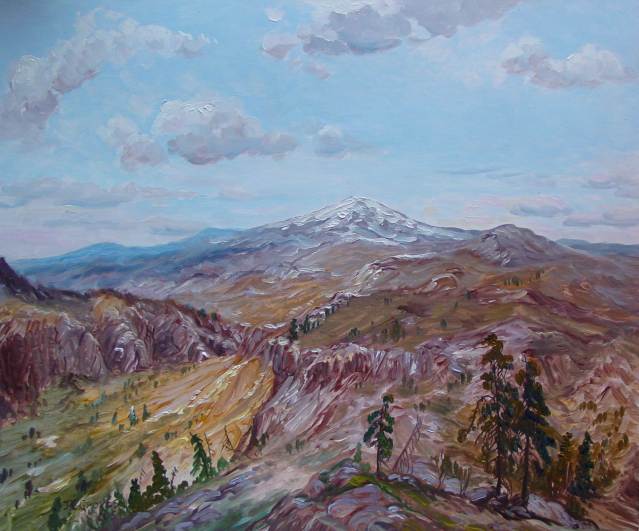
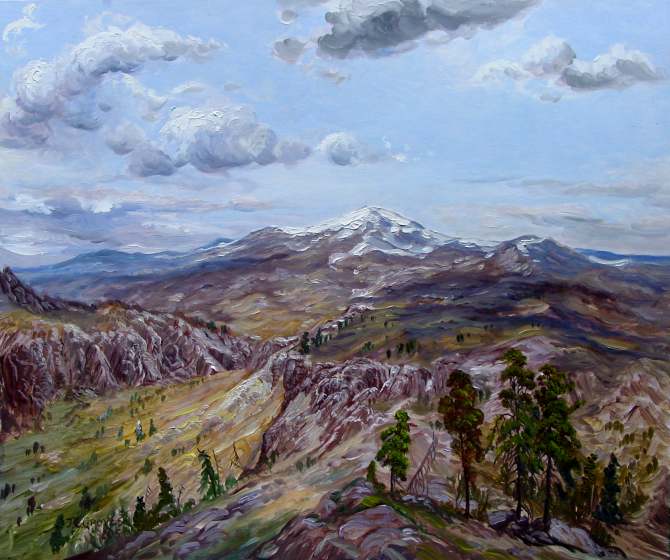
Click here to see my entry on asphaltum oil paint.